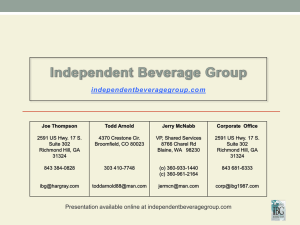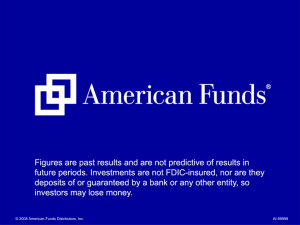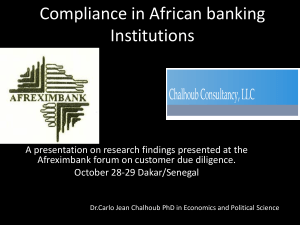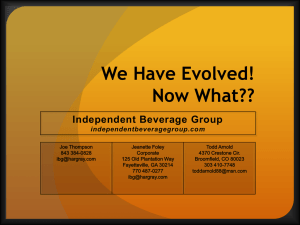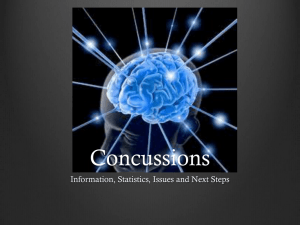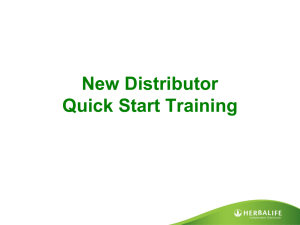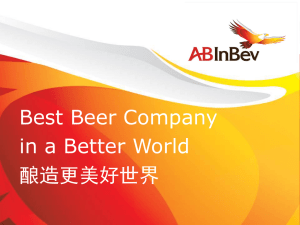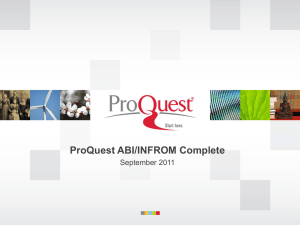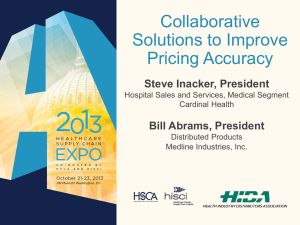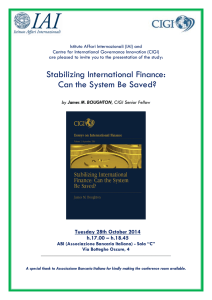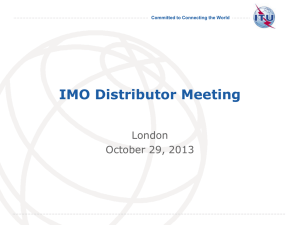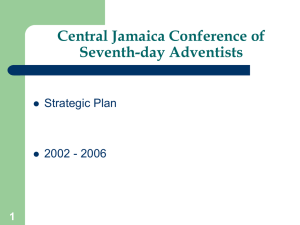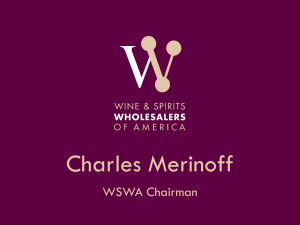The Distribution System of 2015, October 2010, Chicago, IL.
advertisement
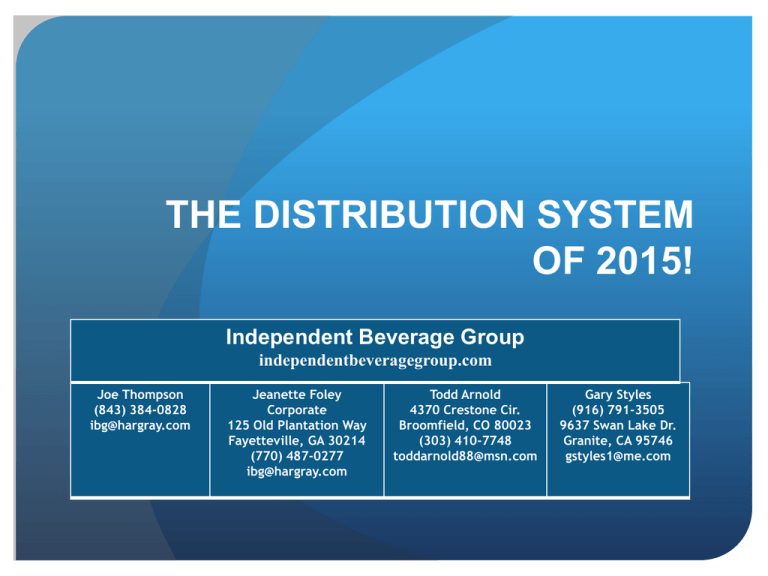
THE DISTRIBUTION SYSTEM OF 2015! Independent Beverage Group independentbeveragegroup.com Joe Thompson (843) 384-0828 ibg@hargray.com Jeanette Foley Corporate 125 Old Plantation Way Fayetteville, GA 30214 (770) 487-0277 ibg@hargray.com Todd Arnold 4370 Crestone Cir. Broomfield, CO 80023 (303) 410-7748 toddarnold88@msn.com Gary Styles (916) 791-3505 9637 Swan Lake Dr. Granite, CA 95746 gstyles1@me.com Agenda I. Industry Overview II. Supplier Changes III. Consolidation IV. Perils of Not Eliminating Redundant Cost V. Distribution Systems of 2015! VI. Summary I. Industry Overview • Volume – – Volume is down and it will be for awhile. Why? • • • • • • • – Leadership Life cycles of mega brands (6) Pricing Marketing Mega / non-mega confusion Competition for other beverages accelerating – Energy Drinks, Water, Vitamin Water, Coffee, Health Food Beverages. Competition for disposable income increasing. – Lottery, Cigarettes, Gas. Duopoly influence • Characteristics of a duopoly. – Aggressive pricing, reduced service, self-focused, less innovation, protect status quo. » Are we less competitive? TWO TEXTBOOK PRODUCT LIFE CYCLE CURVES Introduction Growth Maturity Decline Budweiser Standard Product Life Cycle I. Industry Overview Margins Stable (but) Costs Starting to escalate. Profits Good but no longer growing. I. Industry Overview • Conclusion – Volume will decline. – Profits will begin to leak slowly. – The duopoly environment is having a predictable effect on our industry. • We are becoming less competitive. – Many products are aggressively going after the shrinking disposable income of consumers. • Consumers are harder to reach with historical beer marketing. • Mega brands have not effectively adjusted to new marketing methods. II. Supplier Changes ABI ABI network is going non-exclusive. If ABI does nothing they will lose retail performance. Hard for distributors to adjust from old regime to new. ABI focused on savings. Distributors focused on other brands. ABI / distributors are out of sync. The original concern about InBev acquisition – “ will they be brand builders”? II. Supplier Changes • MillerCoors – Focused on savings. – Culture issues still exist. – Distributors somewhat apprehensive. The question prior to merger was “can they turn around Lite and if yes, can they effectively market 2 premium light beers together.” • Craft / Imports / Regionals – Looking at ABI distributors more aggressively. Conclusion: 80% of volume focused on saving money. • Old model: volume, brand building. New model: margin, short-term profit. III. Consolidation Views Of Risk Buyers see Sellers see Less Risk Emotion More Risk Economics 20%++ gap in perceived value difference between seller and buyer. Sellers looking backwards, buyers looking forward. Less aggressive buyers Intense emotion / litigation Slowdown in reducing redundant cost through consolidation. III. Consolidation • ABI consolidation. – Branches in several major markets. • • • New York, Boston, San Diego, Los Angeles, Miami, Denver. Will buy more major markets when possible. Extra opportunity for markets contiguous to branches. – Economics more difficult than MC. • • Stand alone / horizontal vs. vertical. Buying 50% SOM (stand alone) vs. putting together 25% / 25% (vertical). – This problem creates an opportunity for ABI to seek synergies with another system. – Mega distributor trend vs. culture of control creates potential conflict. – More sellers now than in past. • • Lost emotional hook associated with previous administration. Fear of unknown. III. Consolidation • MC current consolidation. – 75% combined. • Several others in play. • IBG predicts 90% in next 3 years. – Price / size of remaining non-consolidated distributors an issue. • NY, Ft. Worth, Austin, Philadelphia, Minneapolis, Las Vegas. – Low fruit already picked. • People left are able to stay. – Mega distributors to buy / merge mega distributors soon. III. Consolidation • What will cause consolidation to accelerate? – Pain • Less profit (volume, margin, cost). • Pressure from suppliers. • Costco winning in WA. • Increase in taxes. – Pleasure • Industry volume growth (craft, import, regionals). • Buyers willing to pay more. • Cost of money remains low (double edged sword). III. Consolidation • Conclusion. – Process of consolidation is more difficult, time consuming and dynamic than ever. Will only get harder moving forward. • Secondary suppliers often hold trump card. – Should eliminate redundant costs vs. cutting service or brand building activities. – We are an industry of turtles, not rabbits but this needs to change. • We live in a world of speed. IV. Perils of Not Eliminating Redundant Cost Retail distribution systems are getting better. Box stores and some supermarkets can warehouse and deliver beer for 12% - 15% (not rotate and merchandise). Wal Mart puts product on their shelves @ 10% less than its closest competitor. They obsessively measure cost. Are any retail distribution systems more efficient than our current 3-tier model at logistics? Retail initiatives. 7-11 Southern Cal test (fewer trucks, night delivery, private label). Costco. If middle tier becomes logistics oriented and loses brand building skills why does it deserve 25% margin? IV. Perils of Not Eliminating Redundant Cost Status quo will be impossible to maintain much longer. Decide whether we want to be logistics systems, brand builders or something in-between. 7 to 10 point spread between operating cost and gross sales? Consumers want lower prices. Suppliers want fewer distributors. Government wants more money. Environmental and social concerns will become more prevalent (carbon footprint, traffic congestion, DUI, ignition locks, .08). V. Distribution Systems of 2015! • ABI / Pepsi or MC / Coke combinations would increase the distribution profit pool substantially. – Way to dramatically improve ABI distribution efficiency. • Reduce operating cost to less than 15% quickly. • Enhanced retail channel distribution flexibility. • Catch up fast on MC mega distributors. – ABI / Pepsi currently working together. – MC / Coke. • Cultural issues. – Currently working in Wyoming, Mississippi, Kentucky, Utah, Iowa, New Mexico, North Carolina. Previously worked in New York. – IBG prediction: ABI / Pepsi will will work together more and MC and Coke will fight to prevent any combination. V. Distribution Systems of 2015! One distributor per market. Emotional reaction by suppliers. Anti-trust potential. Economic reality in some markets. Rural Major markets? SOM imbalance. Separate selling from warehouse and delivery. Currently working in CO, AZ, MN. V. Distribution Systems of 2015! • Mergers – More prevalent but difficult to accomplish. • • • • • Extended time line to complete. Solves money problem. Particularly important for ABI. Recent significant mergers. – Two in North Carolina. – Tennessee. – San Diego. – Portland. Berkshire Hathaway / Empire Distributing. – Burlington Northern Rail. – McClane Trucking. – Name comes up a lot. • Relationship with InBev board members. V. Distribution Systems of 2015! • Shared services. – Theoretically good but difficult to get done. – Start small. • Idaho. • Wine / spirits / beer. – Republic National / Crescent Crown. – Glazer’s. • Currently 13M cases of beer. – Northwest has unique approach. • • Young’s / Columbia Odom / Southern. • Conclusion: the 3-tier model of today is poised for significant change. – Will evolve in many unique ways. VI. Summary • Industry volume will continue to decline. • Suppliers/distributors are both doing the same thing and blaming each other. – • Consolidation will accelerate when pain / pleasure increases. – • Develop a more competitive approach. Distribution system needs new vision to balance logistics and brand building. – • With beer distributors it takes pain and pleasure. Suppliers / distributors need to adjust duopoly attitude. – • Taking cost out aggressively. Unique combinations will emerge faster. Consumers have more options and are seeking them. – Pricing has been too aggressive particularly at below premium. Independent Beverage Group
